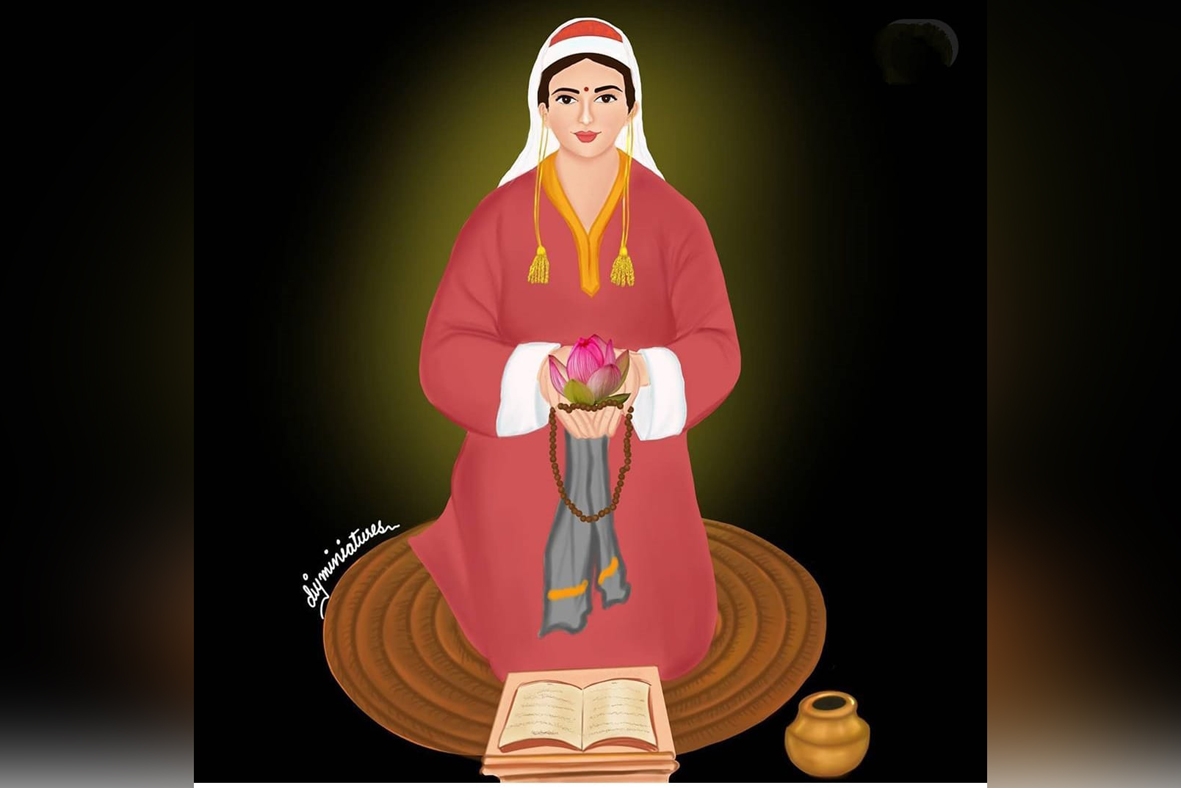Dr. Daleep Pandita
Holly divine Shakti Swaroop of Mata Sharika of Hari Parbat Shrine (Mata Durga) in Kashmir, commonly referred as Alakheshwari Mata Shree Roopa Bhawani Jee, shines as a bright star in the galaxy of mystic saints and sufis of Kashmir.
It is believed that pleased with his great devotion, Mata Sharika in the form of a little girl appeared before her staunch kashmiri pandit devotee, Madhav Joo during auspicious ocassion of Brahma Muhurta and asked him ” speak out your wish “. Prostrated at Mata’s feet, he submitted that ” I wish you are born as my daughter “. Mata Sharika granted the boon by giving birth to a girl child to his wife in the early morning of mag Jyaistha Paurnamasi 1621 AD at Safakadal locality in Srinagar city of Kashmir, which chronicled as the birth of Mata Roopa Bhawani Jee.
During these days, the birth of a girl child in a household of kashmiri pandit was believed to be the form of Mata Raganya or Mata Durga or Mata Lakshmi, hence she was named as ” Alakshyeshwari ” meaning one who is unnoticeable. It is also referred to the Goddess in unnoticeable form of life. It is said that since her birth, this baby girl had spiritual powers and divine touch in her body. Maintaining his family traditions, her father , as her Guru, continued to preach her teachings of Vedas and Upnishads at her tender age.
From her early childhood days, due to influence of Trika Shaivism, Mata started to reshape the prevailing Kashmiri household culture in to divine sanity and encouraged spiritual devotion that helped in reduction of difference of opinion and resolution of various socio religious conflicts. Delicately Mata also started cultivating tolerance that generated love for each other and started becoming a social reformer ever since Mata came to her senses.
At that time, due to the threat of ruling Pathans, parents of Mata preferred to marry her at a very young age, wherein her parental-in-laws could not understood her spiritual nature, ultimately subjected to her ill-treatment. As per custom on a festive occasion at her in-laws home , her father presented traditional sweet rice ” Kheer ” in a small earthen pot for its distribution among their relatives. Seeing its small size, her mother-in-law sarcastically remarked ” How can I distribute such a small quantity among so many relatives ” and ordered to return it. No matter its size, Mata humbly requested her ” please start its distribution and don’t look inside the pot “. Reluctantly she started distributing Kheer and it seemed that Kheer lasted forever. Finally she got tired and opened the lid to look in to the pot – that was empty.
Everyday morning Mata used to go to Hari Parbat shrine for prayers irrespective of prohibitory dictates from her in-laws, but for its continuance of the cause, she sacrificed her short period married life and finally went back to her parental home. It is from there only that depending upon the piousness of the situations, the series of her miracles started happening.
In pursuit of solitary location for continuing her spiritual sadhana, Mata went to Manigam, then to Vaskura followed by Cheshma-Sahib, all village hamlets in central Kashmir, away from the materialistic world. She preferred to remain in the company of saints, learned people and devotees all over to follow the path of spirituality. The great old chinar tree on the banks of river Sind in Manigam, the culmination of a half-burnt branch planted by Mata, is still standing there as a mute but living witness to her spirituality.
A blind man who sincerely served Mata with his full devotion, got back his vision and to address water woes of locals, Mata dug a well at Vaskura, whose water is considered to be pure and pious . There are some other miracles Mata did for her devotees during young days of her life. Mata’s brother, also her devotee, requested her to bless his illiterate son. Mata gave him a pen and paper and asked him to write and he got transformed to write like an educated person.
Right from her early days of spirituality, Mata preached much needed awareness among innocent women folk for development of their divine feeling of self respect and nurtured their sentiments for the eternal peace for the peace of the society, which under present times is seen as ” Women empowerment “.
Trending Now
E-Paper


